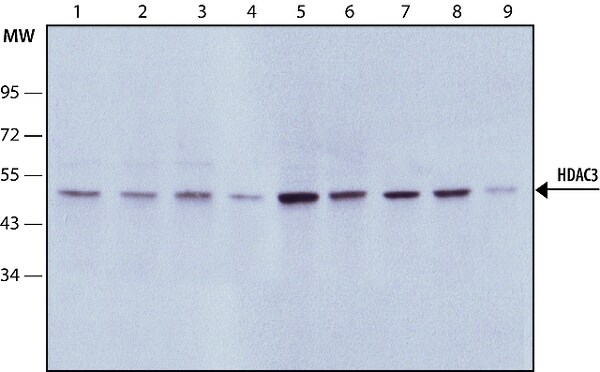Anti-HDAC3 antibody (ab7030)
Key features and details
- Rabbit polyclonal to HDAC3
- Suitable for: ICC, WB
- Reacts with: Mouse, Rat, Human, African green monkey, Chinese hamster
- Isotype: IgG
Overview
-
Product name
Anti-HDAC3 antibody
See all HDAC3 primary antibodies -
Description
Rabbit polyclonal to HDAC3 -
Host species
Rabbit -
Tested Applications & Species
See all applications and species dataApplication Species ICC HumanWB Human -
Immunogen
Synthetic peptide corresponding to Human HDAC3 aa 411-428 conjugated to Keyhole Limpet Haemocyanin (KLH). The epitope recognized by the antibody is resistant to routine formalin-fixation and paraffin-embedding.
Sequence:C-NEFYDGDHDNDKESDVEI
-
General notes
The Life Science industry has been in the grips of a reproducibility crisis for a number of years. Abcam is leading the way in addressing the problem with our range of recombinant monoclonal antibodies and knockout edited cell lines for gold-standard validation.
One factor contributing to the crisis is the use of antibodies that are not suitable. This can lead to misleading results and the use of incorrect data informing project assumptions and direction. To help address this challenge, we have introduced an application and species grid on our primary antibody datasheets to make it easy to simplify identification of the right antibody for your needs.
Learn more here.
Properties
-
Form
Liquid -
Storage instructions
Shipped at 4°C. Store at +4°C short term (1-2 weeks). Upon delivery aliquot. Store at -20°C or -80°C. Avoid freeze / thaw cycle. -
Storage buffer
pH: 7.40
Preservative: 0.097% Sodium azide
Constituent: 0.0268% PBS -
 Concentration information loading...
Concentration information loading... -
Purity
IgG fraction -
Purification notes
Whole antiserum is fractionated and further purified by anion-exchange chromatography to provide the IgG fraction of antiserum that is essentially free of other rabbit serum proteins. -
Clonality
Polyclonal -
Isotype
IgG -
Research areas
Images
-
All lanes : Anti-HDAC3 antibody (ab7030) at 1/5000 dilution
Lane 1 : HEK-293T whole cell lysate.
Lane 2 : HeLa whole cell lysate.
Lane 3 : K562 whole cell lysate.
Lane 4 : COS-7 whole cell lysate.
Lane 5 : CHO whole cell lysate.
Lane 6 : NIH-3T3 whole cell lysate.
Lane 7 : Neuro-2a whole cell lysate.
Lane 8 : PC-12 whole cell lysate.
Lane 9 : NRK whole cell lysate.
Secondary
All lanes : Goat Anti-Rabbit IgG-Peroxidase and a chemiluminescent substrate.
Predicted band size: 49 kDa
-
Immunocytochemical immunofluorescence analysis of HeLa cells labelling HDAC3 with ab7030. Cells were fixed and permeabilized with cold methanol followed by a cold methanol and acetone solution. Fixed cells were stained with ab7030 at a 1/200 concentration. The secondary used was a Goat Anti-Rabbit IgG, Cy3 conjugate.
-
 Western blot - Anti-HDAC3 antibody - ChIP Grade (ab7030) This image is courtesy of an anonymous AbreviewAll lanes : Anti-HDAC3 antibody (ab7030) at 1/10000 dilution
Western blot - Anti-HDAC3 antibody - ChIP Grade (ab7030) This image is courtesy of an anonymous AbreviewAll lanes : Anti-HDAC3 antibody (ab7030) at 1/10000 dilution
Lane 1 : Whole cell lysate from human HEK293 cell line
Lane 2 : Whole cell lysate from human HEK293 cell line treated with HDAC3 gene silencing shRNA
Lysates/proteins at 20 µg per lane.
Secondary
All lanes : HRP-conjugated goat anti-rabbit Ig at 1/5000 dilution
Developed using the ECL technique.
Performed under reducing conditions.
Predicted band size: 49 kDa
Exposure time: 10 seconds
-
 Immunocytochemistry - Anti-HDAC3 antibody (ab7030) This image is courtesy of Michael Mancini, Baylor College of MedicineCells were fixed with 4% formaldehyde in PEM buffer. The coverslip was incubated in blocking buffer of 5% powdered milk in TBS-T plus 0.02% sodium azide for 1 hour at room temperature. Blocking buffer was removed and primary antibody was added at a dilution of 1/5000 and incubated overnight at 4 degrees celsius. The coverslips were then washed 4-5 times with blocking buffer for 5 minutes. Secondary antibody, goat anti-rabbit Alexa 594, was added at a dilution of 1/1000 and incubated at room temperature for one hour. From this point on coverslips were covered with foil to protect them from light. They were washed 5 times with TBS-T and then one time with PEM, for 5 minutes each wash. The coverslips were fixed 10-30 minutes in 4% formaldehyde in PEM buffer, then washed 3 times with PEM buffer for 5 minutes. 0.1M ammonium chloride in PEM buffer was added for 10 minutes to quench auto-florescence, and then slips were washed 2 times for 5 minutes in PEM followed by 3 washes for 5 minutes in
Immunocytochemistry - Anti-HDAC3 antibody (ab7030) This image is courtesy of Michael Mancini, Baylor College of MedicineCells were fixed with 4% formaldehyde in PEM buffer. The coverslip was incubated in blocking buffer of 5% powdered milk in TBS-T plus 0.02% sodium azide for 1 hour at room temperature. Blocking buffer was removed and primary antibody was added at a dilution of 1/5000 and incubated overnight at 4 degrees celsius. The coverslips were then washed 4-5 times with blocking buffer for 5 minutes. Secondary antibody, goat anti-rabbit Alexa 594, was added at a dilution of 1/1000 and incubated at room temperature for one hour. From this point on coverslips were covered with foil to protect them from light. They were washed 5 times with TBS-T and then one time with PEM, for 5 minutes each wash. The coverslips were fixed 10-30 minutes in 4% formaldehyde in PEM buffer, then washed 3 times with PEM buffer for 5 minutes. 0.1M ammonium chloride in PEM buffer was added for 10 minutes to quench auto-florescence, and then slips were washed 2 times for 5 minutes in PEM followed by 3 washes for 5 minutes in























